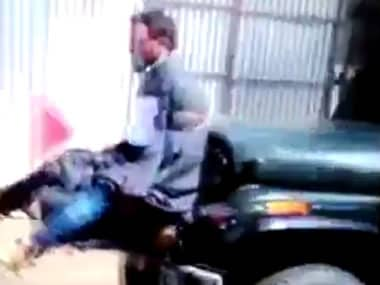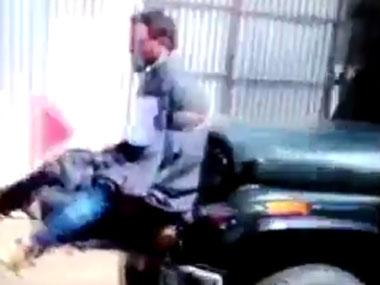This much is clear about the curious case of the young citizen who was paraded around several villages in Budgam district on the bonnet of an army jeep on 9 April: It was done by an army major. The panicked security staff at a polling booth had appealed to the army to save them. The booth was under attack with a barrage of stones. [caption id=“attachment_3388446” align=“alignleft” width=“380”]  Screengrab from video. Courtesy Omar Abdullah’s Twitter handle[/caption] Beyond that, versions differ. The youth says he was returning after voting when the army picked him up and turned him into an injured, unwilling, and extremely unhappy deterrent. The army major says he leapt off his jeep in front of the booth, caught four stone-pelters with the help of his troops and tied the fiercest stone-pelter to his jeep. According to this version, after he did that, stone-pelting ceased immediately. Exponential effect The bottom line is that Kashmiris have been mortified and humiliated by this public display of the might of the State. That mortification is far more crucial than whether or not the man actually pelted stones, for the battlefields of hearts and minds is extremely crucial in this sort of civil war. A simple arithmetical calculation of cause and effect is far too blinkered to be of much use. The exponential effect of the image on the public psyche is more relevant. Only fools — including bloody-minded ones — would ignore the fact that narratives on social media, built around such powerful images, can be the key to winning or losing: Both on the ground and on international screens, councils and chanceries. While a particular major may have succeeded in stopping further pelting of stones at a particular polling booth, the net effect on the larger civil war has been to heighten the odds against the State. Rather than focusing on the officer in question, we ought to focus on the army brass who have drawn up — or failed to adequately draw up — standard operating procedures, and broad-strokes policy directives. For this is a critical phase in an emergent civil war. A mailed-fist approach could cost the nation dearly. Hearts and minds It was at the beginning of the most dangerous phase of militancy in Kashmir that the army — and the state apparatus of which it is a part — decided in 1998 that their objective in Kashmir was winning hearts and minds (Wham). Wham was implemented during the most lethal phase of suicide attacks, which lasted from 1999 to 2001. Then Prime Minister Vajpayee’s announcement of a unilateral ceasefire by security forces during Ramzan in November 2000 had a huge and very positive impact on the Kashmiri psyche. Overall, Wham played a role in bringing about relative peace and near normalcy by the middle of the next century. Compared to a decade earlier, the situation in Kashmir was transformed. It has become clear in recent weeks that the attitude and policies of the central government have changed. ‘Teach them a lesson’ appears to be the underlying motive of the repressive tactics that the forces have adopted. For example, the decision to enter the Pulwama college campus last week, and beat students there, was ill-advised. First, an army officer who went to meet the principal to discuss an event chose to go in an armoured vehicle: The frightening-looking Israeli-built Caspar. Students stoned the vehicle while it was on campus. Subsequently, a police vehicle, which is normally stationed outside the college, entered. The police then wrought tortuous havoc. Like the Budgam-based officer’s decision to make one young man a deterrent, the mortifying anger generated by images of what happened at the college generated a strong ripple of anti-State sentiment. Demonstrations spread on Monday to other colleges, including Srinagar’s SP College and the degree colleges at Baramulla and Shopian. This is tragic, for colleges have so far functioned relatively peacefully. Turning them into hotbeds of anti-State activism— as Kashmir University has been for a while — could cause great harm. This plays into the hands of anti-State forces.
This much is clear about the curious case of the young citizen who was paraded around several villages in Budgam district on the bonnet of an army jeep on 9 April: It was done by an army major. The panicked security staff at a polling booth had appealed to the army to save them. The booth was under attack with a barrage of stones.
David Devadas is an expert on politics and geopolitics. Formerly a Senior Fellow at the Nehru Memorial Museum and Library, Visiting Professor at Jamia Millia Islamia, and Political Editor of Business Standard, he is currently Distinguished Fellow at the Institute for Social Sciences. He has written books on Kashmir, on youth, and on history. He has been a radio compere, guest faculty at JNU's Academic Staff College, St Stephen's College and Hindu College. He has worked for the Indian Express, The Hindustan Times, India Today, The Economic Times and Gulf News. His most impactful article, on a murder cover-up, prevented a Congress President from becoming prime minister. One led to the closure of an airline, and another created a furore and consequent clean-up in Delhi's health department. Several have correctly predicted election results in key states, and a series of reports from Srinagar made the government aware of how unsettled the situation there was in 1990. He is an alumnus of St Xavier's School, St Stephen's College, and the Indian Institute of Mass Communication. He has lived for extended periods in Geneva and Berlin, and has traveled to almost 50 countries. He enjoys various kinds of music, theatre, design, architecture and art. see more


)

)
)
)
)
)
)
)
)



